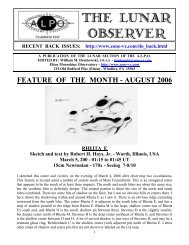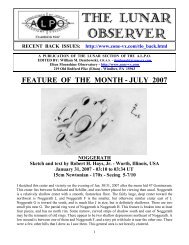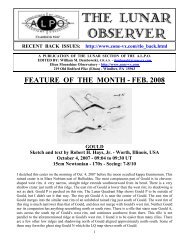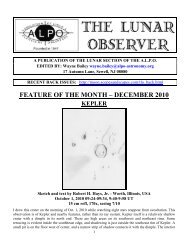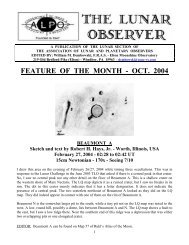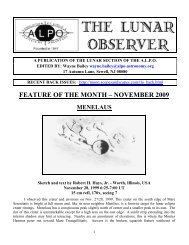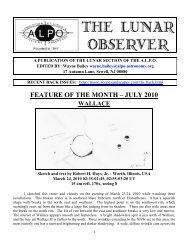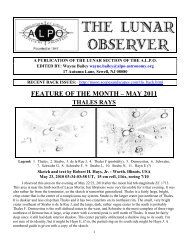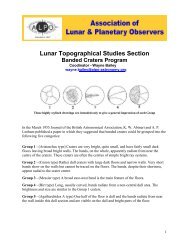LUNAR CRATER RAYS: COMPOSITIONS AND MODES OF ORIGIN ...
LUNAR CRATER RAYS: COMPOSITIONS AND MODES OF ORIGIN ...
LUNAR CRATER RAYS: COMPOSITIONS AND MODES OF ORIGIN ...
Create successful ePaper yourself
Turn your PDF publications into a flip-book with our unique Google optimized e-Paper software.
A PUBLICATION <strong>OF</strong> THE <strong>LUNAR</strong> SECTION <strong>OF</strong><br />
THE ASSOCIATION <strong>OF</strong> <strong>LUNAR</strong> <strong>AND</strong> PLANETARY OBSERVERS<br />
EDITED BY: William M. Dembowski, F.R.A.S. - Elton Moonshine Observatory<br />
219 Old Bedford Pike (Elton) - Windber, PA 15963 - Dembowski@zone-vx.com<br />
FEATURE <strong>OF</strong> THE MONTH - AUGUST 2004<br />
CAUCHY & ENVIRONS<br />
Sketch and Text by Robert H. Hays, Jr. - Worth, Illinois, USA<br />
February 26, 2004 - 01:06 UT<br />
15cm Newtonian - 170x - Seeing 8/10<br />
I sketched this area on the evening of February 25/26, 2004 while watching two occultations. Cauchy<br />
itself is a rather ordinary crater except that it cast shadows that were considerably longer at its north and<br />
south ends than in its middle. The surrounding area was more interesting. The fault Rupes Cauchy lies<br />
south and west of Cauchy. This fault cast a conspicuous shadow that was wider toward the west. The<br />
crater Cauchy B interrupted it to the west, and it continued beyond that crater, but the shadow was not<br />
nearly as wide west of Cauchy B as it was east of that crater. There were two strips of shadow south of<br />
the fault; perhaps these were from branches of Rupes Cauchy. I saw a few small crater pits near the<br />
fault. Cauchy F appears to be one of two pits between Cauchy and Cauchy B. Cauchy E is just south of<br />
Cauchy, and further south is Cauchy C. The Lunar Quadrant Map shows Cauchy C north of Rupes<br />
Cauchy but I saw it south of the main fault.<br />
Rima Cauchy lies to the north and northwest. This rille is split into two parts. One segment is straight<br />
and lies north of Cauchy while the other segment makes a gentle curve around Cauchy A. This segment<br />
appears to be more curved than is shown on the Lunar Quadrant Map. The gap between the segments<br />
1
looks larger than shown there also. Cauchy D lies east of Cauchy; these two craters both have substantial<br />
interior shadows. Cauchy A, however, appears to be much shallower. Its interior shadow is much less<br />
than that of Cauchy D, though these craters are about the same size. An assortment of hills was noted<br />
north of Cauchy D. I also saw four diffuse bright spots in this area. Two were along Rima Cauchy, one<br />
was at the north end of Cauchy, and one was at the north end of an elongated hill north of Cauchy D. I<br />
couldn’t see any shadowing associated with these bright spots.<br />
<strong>LUNAR</strong> TOPOGRAPHICAL STUDIES<br />
Acting Assistant Coordinator – William M. Dembowski, FRAS<br />
Dembowski@zone-vx.com<br />
OBSERVATIONS RECEIVED<br />
MICHAEL AMATO - WEST HAVEN, CONNECTICUT, USA<br />
Ray Maps of Proclus (3), Menelaus (3), Messier (3), Aristarchus (3), Kepler (3)<br />
DANIEL DEL VALLE - AGUADILLA, PUERTO RICO<br />
Sketches of Harpalus, Seleucus, Dome near Tobias Mayer<br />
Digital images of Cleomedes, Endymion, Janssen, Proclus, Snellius<br />
COLIN EBDON - COLCHESTER, ESSEX, ENGL<strong>AND</strong><br />
Sketches of Fabricus & Metius & Brenner, Schiller Annular Plain (2), Heraclitus, Sinus Iridum,<br />
Metius to Neander<br />
HOWARD ESKILDSEN - OCALA, FLORIDA, USA<br />
Digital image of Marius Hills & Reiner Gamma, Region from Rumker to Aristarchus, Ramsden to Mare<br />
Humorum, Gassendi and nearby rilles<br />
RAFFAELLO LENA - ROME, ITALY<br />
Digital image of Clavius & Tycho & environs<br />
GUIDO SANTACANA - SAN JOSE, PUERTO RICO<br />
Digital images of Copernicus, Tycho<br />
ROBERT WLODARCZYK - CZESTOCHOWA, POL<strong>AND</strong><br />
Sketches of Plateau and Rays of Gambart A, Region from Piccolomini to Fracastorius<br />
Observations submitted should include the following:<br />
Name and location of observer<br />
Name of feature<br />
Date and time (UT) of observation<br />
Size and type of telescope used<br />
Magnification (for sketches)<br />
Medium employed (for photos and electronic images)<br />
2
RECENT TOPOGRAPHICAL OBSERVATIONS<br />
GASSENDI & ENVIRONS<br />
Digital image by Howard Eskildsen - Ocala, Florida, USA<br />
May 30, 2004 - 01:04 UT<br />
10 inch Refractor - 2x Barlow - Nikon Coolpix 4300<br />
HERACLITUS<br />
Sketch by Colin Ebdon - Colchester, Essex, England<br />
June 25, 2004 - 21:45 to 22:45 UT<br />
7 inch Maksutov-Cassegrain - 225x - Seeing AIII (variable)<br />
3
RECENT TOPOGRAPHICAL OBSERVATIONS<br />
CLAVIUS, TYCHO, <strong>AND</strong> ENVIRONS<br />
Digial image by Raffaello Lena - Rome, Italy<br />
June 27, 2004 - 19:43 UT<br />
10cm f/15 Refractor - 12.5mm EP - Olympus Camedia C310<br />
HARPALUS<br />
Sketch by Daniel del Valle - Aguadilla, Puerto Rico<br />
June 24, 2004 - 00:01 to 00:25 UT<br />
120mm Refractor - 333x - Orion V-Block Filter<br />
4
LIGHT CUP POURED TEA DOWN <strong>LUNAR</strong> TROUGH<br />
Ron B[ee] – June 22, 2004<br />
My 4-inch TV-102 Light Cup set out to find Apollo 17 tonight on a 4-day old Moon. The seeing was<br />
poor and couldn't support more than 110x (8mm TV Radian) and at times 146x (6mm Radian) could just<br />
barely make it.<br />
Using my Modern Moon book as a guide, the Light Cup has no trouble showing me the nearby<br />
Vitruvius and Littrow craters as well as the South and North Massif. I had planned to look for Crater<br />
Camelot but it was hopeless judging how small the Massif looks. We'll have to retry at a higher sun<br />
angle.<br />
While scouting around the weird looking Crater Torricelli area, I came across what looked like a semicircular<br />
trough around a nameless mountain range between Crater Hypatia and Rimae Hypatia (see red<br />
curves in the image from the Consolidated Lunar Atlas E5).<br />
Plate E5 Plate E6<br />
The depth of the trough was very evident due to the very low sun angle as part of the mountain range<br />
was still hidden beyond the terminator. The wrinkle ridges (left curve) and the plain where Crater<br />
Hypatia C (somebody had made a circle around it in the center of the image) resides, is noticeably<br />
higher than the trough, especially near the lower part of the image. If you look carefully, you might be<br />
able to see the trough in the photo as well! Why, the Light Cup thinks the whole mountain range and<br />
semi-circular plateau looks like a semi-circular Lunarian's fortress !<br />
So are there depths around this region perhaps where lava used to be carried into Mare Tranquilitatis or<br />
was it simply a sun angle illusion? As you can see in the E6 plate of the Consolidated Lunar Atlas<br />
(taken when the Moon was much older in its cycle), the depth perception has all disappeared.<br />
So what you think? Has anyone noticed this phenomenon?<br />
Ron B[ee]<br />
PS - Ok, my Light Cup knew it's impossible to see Apollo Lunar Lander, but it sure does hurt nothing<br />
none to try.<br />
5
INTERNATIONAL BRIGHT <strong>LUNAR</strong> <strong>RAYS</strong> PROJECT<br />
EXCERPT <strong>OF</strong> THE MONTH<br />
<strong>LUNAR</strong> <strong>CRATER</strong> <strong>RAYS</strong>: <strong>COMPOSITIONS</strong> <strong>AND</strong> <strong>MODES</strong> <strong>OF</strong> <strong>ORIGIN</strong> (Part 2):<br />
B.R. Hawke 1, D.T. Blewett 1, P.G.Lucey 1, C.A. Peterson 1, J.F. Bell III 2, B.A. Campbell 3<br />
, and M.S. Robinson 4,<br />
1 Planetary Geosciences/HIGP, Univ.of Hawaii, Honolulu, HI 96822,<br />
2 CRSR, Cornell Univ., Ithaca, NY 14853,<br />
3 CEPS, National Air & Space Museum, Washington, DC 20560,<br />
4 Dept. of Geological Sciences, Northwestern Univ., Evanston, IL 60208.<br />
Lichtenberg Crater Rays:<br />
Lichtenberg crater (diameter = 20 km) is located in Oceanus Procellarum on the western portion of the<br />
lunar nearside (31.8° N, 67.7° W). This Copernican-aged impact structure displays a relatively highalbedo<br />
ejecta blanket and ray system to the north and northwest. However, Lichtenberg ejecta is<br />
embayed by mare basalt south and southeast of the crater. The FeO map produced for the Lichtenberg<br />
region indicates that the ejecta and rays north and northwest of the crater exhibit relatively low FeO<br />
abundances. These deposits appear to be dominated by low-FeO highlands debris. The maturity image<br />
demonstrates that these highlands-rich ejecta deposits and rays are fully mature. Hence, the Lichtenberg<br />
rays exhibit a relatively high albedo because of their composition. These mature highlands-rich rays<br />
appear bright in comparison to the adjacent mature mare surfaces. These “compositional” rays stand in<br />
stark contrast to the immaturity rays associated with the Messier crater complex.<br />
Tycho Ray in Mare Nectaris:<br />
A major ray from Tycho crater crosses much of Mare Nectaris. The 80-km long ray segment northeast<br />
of Rosse crater (17.9° N, 35° E) has a somewhat conical shape, ranging in width from 8 km near Rosse<br />
to 16 km northwest of Bohnenberger crater. Spectra were obtained for Rosse crater (diameter = 12 km),<br />
mature mare units, and two small areas on the Tycho ray northeast of Rosse. Both of the spots on the ray<br />
are located near a Tycho secondary crater cluster which is ~1400 km from the center of the parent crater.<br />
The spectrum collected for a mature mare area east of Rosse exhibits an 8.5% absorption feature<br />
centered at 0.98 µm. Both ray spectra have 11.6% bands centered at ~0.99 µm. It appears that the ray in<br />
the areas for which spectra were collected are dominated by fresh mare debris. These results are in<br />
agreement with those presented by Campbell et al. [6]. These workers noted that the Tycho secondary<br />
craters in the cluster are easily seen in high-resolution 3.0-cm radar images, and a radar-bright area<br />
extends 10-15 km downrange of Tycho from the approximate center of the cluster. In addition, they<br />
noted that the radar-bright region exhibited a deeper “1-µm” feature in multispectral ratio images and<br />
suggested that fragmental material was emplaced well downrange of the visible secondaries, perhaps by<br />
a secondary debris surge. The FeO and maturity images support this interpretation. In summary,<br />
analyses of near-IR reflectance spectra, multispectral imagery, and a variety of radar data suggest that<br />
Tycho ray in Mare Nectaris is dominated by fresh local material excavated and emplaced by secon-dary<br />
craters. While some highlands material from Tycho is undoubtedly present in the ray, the major factor<br />
that produces the brightness of the ray is the immature mare basalt.<br />
6
Tycho Ray Southwest of Nectaris:<br />
We also investigated a continuation of the Tycho ray discussed above in the highlands southwest of<br />
Mare Nectaris. The ray segment studied extends from Wilkins crater (30°S, 19°E) to the northwest rim<br />
of Fracastorius (20°S, 31°E). The FeO and TiO2 values associated with this ray segment are very similar<br />
to those exhibited by the adjacent highlands terrain. The maturity map shows that the brighter portions<br />
of this ray segment are composed of immature material. In summary, this ray is composed of relatively<br />
fresh highlands debris.<br />
References:<br />
[1] Shoemaker E. (1962) in Physics and Astronomy of the Moon, 283.<br />
[2] Pieters C. et al. (1985) J. Geophys. Res., 90, 12393.<br />
[3] Oberbeck V.(1971) Moon, 2, 263.<br />
[4] Schultz P. and Gault D. (1985) J. Geophys. Res., 90, 3701.<br />
[5] Blewett D. et al. (1995) J. Geophys. Res., 100, 16959.<br />
[6] Camp-bell B. et al. (1992) Proc. Lunar Planet. Sci., 22, 259.<br />
[7] Zisk S. et al. (1974) Moon, 10, 17.<br />
[8] Thompson T. (1987) Earth, Moon, Planets, 37, 59.<br />
[9] Hawke B. et al. (1996) Lunar Planet Sci. XXVII, 507.<br />
[10] Lucey P. et al. (1995) Science, 268, 1150.<br />
[11] Lucey P. et al. (2000) J. Geophys. Res., submit-ted.<br />
[12] Hawke B. et al. (1999) Workshop on New Views of the Moon II, 22.<br />
RECENT RAY OBSERVATIONS<br />
KEPLER <strong>RAYS</strong> & REINER GAMMA<br />
Digital image by Howard Eskildsen - Ocala, Florida, USA<br />
10 inch Refractor - 2x Barlow - Nikon Coolpix 4300<br />
7
RECENT RAY OBSERVATIONS<br />
SELEUCUS<br />
Sketch by Daniel del Valle - Aguadilla, Puerto Rico<br />
July 1, 2004 - 02:12 to 02:43 UT<br />
120mm Refractor - 222x - 333x - Orion V-Block Filter<br />
OBSERVING NOTE: Interesting ray system passes near east rim.<br />
Possible origin: Olber’s crater.<br />
BRIGHT PLATEAU & <strong>RAYS</strong> <strong>OF</strong> GAMBART A<br />
Sketch by Robert Wlodarczyk - Czestochowa, Poland<br />
July 7, 2004 - 00:15 to 00:30 UT<br />
18cm Newtonian - 36x - Seeing AII-III<br />
8
TRANSIENT <strong>LUNAR</strong> PHENOMENA<br />
Coordinator – Dr. Anthony Cook – acc@cs.nott.ac.uk<br />
Assistant Coordinator – David O. Darling – DOD121252@AOL.COM<br />
June has been a poor month for observing, presumably due to the Moon’s low altitude in the evening<br />
sky for many northern hemisphere observers. Despite this, routine observations have been received<br />
from: Jay Albert (Florida, USA), Clive Brook (Plymouth, UK), and Marie Cook (Mundesley, UK).<br />
There were also attempts to look for meteor impact flashes in the Earthlit part of the Moon for the June<br />
Bootid meteor shower by Colin Ebdon and Brendan Shaw in the UK and by Raffello Lena of GLR in<br />
Italy. However attempts at observing impact flashes between June 21-24 were largely clouded out<br />
although Colin Ebdon did manage one hour of observing on June 21 st and some observing on June 22 nd<br />
until cloud rolled in - but saw no impact flashes.<br />
Now one of the great things about participating in the TLP program, whatever you think about many of<br />
the past TLP reports, the programme is an excellent way to learn your way around the Moon and to see<br />
many craters under spectacular appearances. Also the observations you provide are of great use to other<br />
researchers in the BAA and ALPO. For example the following Proclus observation (top left) was<br />
received from Jay Albert “The only thing I noticed that looked unusual was the shadow on the east wall<br />
of Proclus. The east wall was divided by a bright vertical feature. To the south of this feature, the<br />
shadow on the crater wall was black (as would be expected). To the north of the bright vertical feature,<br />
however, the shadow started black, but gradually lightened until it ended where the crater wall was<br />
brightly sunlit. I'm used to seeing lunar shadows as black with sharp boundaries, so this struck me as<br />
odd. Since I've never looked closely at Proclus before, it's possible that what I saw was normal for this<br />
solar angle and the intensity difference is due to the color of the feature”. Note all the sketches below<br />
are with north at the top.<br />
2004 Jun 24 UT 01:15-03:15– Jay Albert 1978 Feb 13 UT 18:58-19:08- Tony Cook<br />
Sub-solar point 103.2E, 1.2N Sub-solar point 108.1E, 1.1N<br />
Sub-observer point 7.5W, 5.0S Sub-observer point 5.1E, 4.4N<br />
Solar Altitude +32.5deg Solar Altitude +27.8 deg<br />
279mm Celestron x311 300mm reflector x240<br />
Seeing 8-10 (excellent) Seeing Antoniadi III (moderate)<br />
Transparency magnitude 3<br />
9
2003 Feb 08 UT 02:09-03:07– Robin Gray 2003 Apr 08 UT 03:49-04:50- Robin Gray<br />
Sub-solar point 103.5E, 1.5S Sub-solar point 104.1E, 1.1S<br />
Sub-observer point 1.3W, 3.8N Sub-observer point 6.9W, 2.7S<br />
Solar Altitude +31.3 deg Solar Altitude +30.8 deg<br />
152mm refractor x305 152mm refractor x305<br />
Seeing 6-7 (good) Seeing 5-6 (poor-good)<br />
Transparency 6 Transparency 5-6<br />
Upon receiving this sketch I checked up a few past observations (not many of these are in my database<br />
yet, so apologize to observers whom I have missed out) and found the following additional three<br />
sketches. My own crude sketch (top right) from 1978 confirms a less dark area to the north of the<br />
bisecting line. Robin Gray (Winnemucca, USA) also has a couple of sketches from 2003, his Feb 8 th<br />
observation (bottom left) description is as follows: “The black shadow covering the east 40% of Proclus<br />
last night (Feb 7 th ) had broken up into three patches separated from each other by lighter bands. These<br />
were confined to the east crater wall. Only the central patch was black, the other two were considerably<br />
lighter. Running along the southwest edge of the crater floor was what appeared to be a ridge and on<br />
the east side of the crater floor appeared to be a hill to the north of which was a less elevated plateau.<br />
As the observing period progressed part of the brilliantly illuminated north crater wall developed a<br />
darker area which gradually became more prominent. As the sun is getting higher I would expect<br />
shadows and dark areas to diminish-what was happening here is unknown. However, this is not an<br />
unusual event for this part of Proclus.” In his Apr 8 th observation (bottom right) Robin makes no<br />
mention about the shadow densities.<br />
So what does this tell us? Well Jay’s original suspicion of the bright bisecting line turns out to be a<br />
normal appearance, possibly caused by a notch in the rim, or some other topographic effect. What is<br />
interesting is that he has not drawn in the 2 nd bisecting line or a 3 rd shadow. I doubt if this is a TLP, but<br />
perhaps more due to the Sun being at a sufficiently high altitude that any remaining shadow vanishes.<br />
Why are some shadows black and others grey in Proclus? This could be due to whether shadow is<br />
contiguous and un-interrupted, or whether there are lots of unresolved topography and surface roughness<br />
protruding out of the shadow. Also all four sketches are at different libration angles (sub-observer<br />
lon/lats), so undoubtedly this may have an effect on appearance. Another point to note about Proclus is<br />
that it is only 30km in diameter and subtends a relatively small diameter of less than 15 sec of arc (or<br />
smaller than the disk of Saturn), so it is not surprising that the sketches differ slightly in what can be<br />
resolved and their internal geometric accuracy as seeing conditions will have a drastic effect on what<br />
you can and cannot see.<br />
So what are the guidelines if you see something strange? Firstly make a brief sketch, notes and if you<br />
can please take some CCD images. Next, does the feature change over time? If it is a simple<br />
illumination related effect then it will change gradually. Please also check out the appearance of other<br />
similar sized nearby craters in order to judge whether the effect is seeing related - if so it will affect<br />
others. You should also be looking for colour and brightness variations. I cannot give advice on when it<br />
10
is appropriate to telephone/email myself or David Darling to initiate a TLP alert - this depends upon<br />
individual cases, but we will definitely ask you if nearby features are exhibiting similar effects, so please<br />
be prepared to answer any questions about these.<br />
Further predictions, including the more numerous illumination only events can be found on the<br />
following web site: http://www.lpl.arizona.edu/~rhill/alpo/lunarstuff/ltp.html. For members who do not<br />
have access to the internet, please drop me a line and I will post predictions to you. If you would like to<br />
join the TLP telephone alert team, please let me know your phone No. and how late you wish to be<br />
contacted. If in the unlikely event you see a TLP, please give me a call on my cell phone: +44 (0)798<br />
505 5681 and I will alert other observers. Note when telephoning from outside the UK you must not use<br />
the (0). When phoning from within the UK please do not use the +44!<br />
Dr Anthony Cook, School of Computer Science & IT, Nottingham University, Jubilee Campus,<br />
Wollaton Road, Nottingham, NG6 1BB, UNITED KINGDOM. Email: acc@cs.nott.ac.uk<br />
SELECTED AREAS PROGRAM<br />
Observations Needed<br />
Coordinator - Julius L. Benton, Jr., Ph.D. - jlbaina@msn.com<br />
The missions of Apollo transformed our nearest celestial neighbor from a virtually unknown and<br />
inaccessible object into a relatively familiar world. Including the unprecedented historical events of July<br />
20, 1969, twelve astronauts from Earth have set foot upon the Moon's surface, collecting and returning<br />
to Earth some 380 kg. of rocks and debris from six Apollo ventures. Of course, in mentioning any lunar<br />
explorations from Earth, we cannot omit the small but no less important 130 gm. of rocks gathered<br />
during the unmanned Russian Luna-16 and Luna-20 missions.<br />
Apart from the vast collection of photographs, supplementing previous data from missions such<br />
as Surveyor and Orbiter, the Apollo program enabled equipment to be set up on the lunar surface to<br />
monitor moonquakes, meteoric impacts, thermal characteristics of the lunar surface material, and alleged<br />
magnetic phenomena. Adding to the wealth of accumulated data that now exists has been the massive<br />
collection of photographs of the entire lunar surface made in unprecedented detail in 1994 by the<br />
orbiting Clementine spacecraft. It will be many years, no doubt, before all of this information will be<br />
thoroughly assimilated and developed into a realistic account of the Moon and its cosmic history.<br />
For the amateur astronomer, the Moon has always been a favorite subject for his telescopes, and<br />
until the first really energetic space efforts, he in large part dominated the field of selenography. Now,<br />
with the impact of a great multitude of photographs taken at close-hand, with precise measurements of<br />
the Moon's complex chemical composition, radioactivity, and seismic profile, and following<br />
sophisticated petrographic investigations of lunar materials, one might quickly assume that the work of<br />
the amateur astronomer has been relegated to redundancy or insignificance from our fixed vantage point<br />
in space. Too many people have gotten the idea that no awe and mystery remains about our "Queen of<br />
the Night."<br />
The activities by Apollo astronauts on the Moon and close-range photographic surveys by lunar<br />
orbiting spacecraft are obviously out of the domain of the amateur astronomer. Yet, it must be<br />
emphasized that there are areas of lunar observation that still remain the forte of the amateur astronomer,<br />
fields that may be pursued without an imminent threat of obsolescence by the onslaught of imposing<br />
11
professional equipment. Unlike the professional specialist, the amateur is often blessed with the freedom<br />
to scan a lunar feature of his choice for extended periods of time in hopes of drawing or capturing<br />
photographic or CCD images of low-sun shadows of minor relief features, varying tonal patterns<br />
exhibited in lunar environments exposed to a high sun, and other possible long-term or transient events.<br />
Any observing program, for its results to be scientifically useful, requires of its participants a<br />
suitable blend of preparation, skill, patience, and tenacity. Because of the large image size and<br />
brightness of the Moon, lunar studies are especially suited for amateur astronomers using small to<br />
moderate apertures. More importantly, there have been numerous instances when professional<br />
astronomers, in trying to resolve some observational query by relying solely on existing spacecraft<br />
photographs, have enlisted the services of amateur astronomers. For example, by a fortuitous improper<br />
positioning of the spacecraft camera or as a result of unfavorable solar illumination, an optimum view<br />
was not afforded of the morphology of a particular lunar crater or other feature. Fortunately, amateur<br />
observers were able to come to the rescue by monitoring the specific region of the Moon under the<br />
conditions sought by professional astronomers. In a few cases, needed data already existed in amateur<br />
observational archives. Such cooperative efforts clearly demonstrate how meaningful amateur<br />
observations of the Moon can be.<br />
Lunar Transient Phenomena (LTP)<br />
There are many areas of lunar research in which the skillful and imaginative amateur astronomer<br />
can find worthwhile observational opportunities. One example of a very interesting research program is<br />
the monitoring of Lunar Transient Phenomena (LTP). The LTP represent alleged variations at the lunar<br />
surface that are typically of ephemeral or instantaneous nature and usually are quite unpredictable.<br />
Systematic, simultaneous studies by a team of regular observers using top-quality instrumentation is<br />
especially worthwhile, since under optimum conditions LTP events might be glimpsed for only a few<br />
seconds to some twenty minutes or so. What is of greatest importance within the scope of such a<br />
program is to try to observationally differentiate between LTP "reports" and bona fide LTP events.<br />
No more than a cursory perusal of the available literature will turn up historical accounts of LTP,<br />
and while reports of most activity turn out to be dubious, there are growing numbers of undisputedly<br />
authentic LTP phenomena from analytical evaluations of available data. Some events have been<br />
observed simultaneously by distant and independent observers. As investigative procedures have been<br />
refined and improved over the years, it has been possible to confirm some LTP events photographically<br />
or with CCD techniques.<br />
Of the more than 1,500 LTP reports and events catalogued since A.D. 557, perhaps the widely<br />
publicized Alphonsus spectrograms of Kozyrev in 1958, the observations of Greenacre and Barr of<br />
Aristarchus in 1962, and the Moon-Blink reports of the mid-1960's and early 1970's, are the most<br />
familiar. Observers are generally more prone to study areas on the lunar surface which are known to<br />
have generated LTP reports and events, giving the data sample to date a somewhat lopsided appearance,<br />
but it has become evident that LTP events may take place elsewhere on the Moon and not just in the<br />
aforementioned "preferential" areas. There are many regions on the lunar surface, indeed, which have<br />
been suspected of LTP events, although most of the lesser-known features have never been adequately<br />
followed observationally.<br />
Rare and elusive as they may seem, LTP events do appear to fall within roughly defined<br />
categories. Small, temporary reddish or pinkish patches, presumably due to fluorescence or<br />
incandescent gaseous substances, have been noted shortly after lunar sunrise, while glows lacking any<br />
distinct hue have been noticed, sometimes seen on the night hemisphere of the Moon. Emerging quite<br />
instantaneously or lasting for several minutes have been bright points of light near the lunar terminator<br />
12
or on the darkened hemisphere of the Moon, while rapid fluctuations in the brilliance of a specific area<br />
have been occasionally recorded, again most often in the early lunar morning. Obscurations, visible<br />
directly as "fog" or "mist," or indirectly by concealing or obliterating known surface features, are also<br />
curiously associated with times of lunar sunrise, but not always so. Any number of variations may<br />
sometimes be reported in Earthshine conditions or in conjunction with partial or total lunar eclipses.<br />
From the analytical information to date, it might be concluded that LTP events are probably of<br />
random internal origin and are only weakly attributable to external influences. As noted here, the<br />
phenomena seem to be of several kinds and involve possible gas or gas/dust mixtures, luminescence of<br />
these gaseous substances, and possible luminescence of surface materials. Perhaps many causative<br />
factors operate together to give strong sunrise correlations found in many of the LTP events. Supporting<br />
this tentative conclusion of an internal origin of the LTP is the distribution and association of many LTP<br />
sites with volcanic maria, dark-haloed craters, sinuous rills, and lunar domes.<br />
The Lunar Selected Areas Program (SAP)<br />
Well over a decade ago, the Lunar Transient Phenomena (LTP) Patrol was introduced as a new<br />
program for the A.L.P.O. Lunar Section, and the major thrust of the endeavor was to visually monitor<br />
the supposed transient variations at the lunar surface just discussed. In addition to looking for short-lived<br />
events, individuals were asked to supplement their observations with a monitoring of certain selected<br />
lunar features suspected or historically known to exhibit "seasonal" or long-term phenomena. For<br />
example, a variation in the tone or hue of a given area, which cannot be attributed to varying solar<br />
illumination and which does not repeat systematically from lunation to lunation, has been seen in certain<br />
areas. Principally, these tonal changes occur where dark radial bands or dark haloes are seen within or<br />
around some craters, or where darker regions or patches exist on the lunar surface in limited<br />
environments. Unusual changes in the apparent morphology, pertaining to overall size and shape, have<br />
been detected in conjunction with tonal or color fluctuations in many, but not all, cases. Thus, the<br />
intensive studies of specific features such as Alphonsus, Aristarchus, Eratosthenes, Herodotus, Kepler,<br />
Messier-Pickering, and Plato, have occurred, and as data were accumulated and reports on specific<br />
regions published, new areas were then added to the list (e.g., Atlas, Ross D, Hell, Pico, Piton, Colombo,<br />
etc.).<br />
By 1971, the A.L.P.O. Lunar Recorders decided to segregate the study of LTP from the study of<br />
long-term or "seasonal" events, forming the LTP Survey for strictly transient lunar events and the<br />
Selected Areas Program (SAP) to deal with long-term variations, each area of concentration headed by a<br />
dedicated Recorder. In the years that followed this change, observational data were collected by each<br />
program, catalogued, reduced, and published in the Journal of the A.L.P.O., and the results of both<br />
programs showed real promise. There were quite a few instances of LTP events and recognized<br />
"seasonal" variations apparent in the accumulated data sample.<br />
Indeed, the Selected Areas Program (SAP) and LTP Survey represents meaningful enterprises at<br />
the fundamental level of amateur observational astronomy. A major goal of organizations like the<br />
A.L.P.O., these are pursuits that are largely concerned with long-term visual monitoring of variable<br />
phenomena at the surface of the Moon. The scope of such work has definitely not been rendered<br />
obsolete by spacecraft gathering such a great wealth of information about our satellite. Persistent, patient<br />
observers, participating in the A.L.P.O. LTP Survey and Selected Areas Program (SAP) can successfully<br />
and vitally supplement the findings of space missions and other ongoing professional research,<br />
increasing our overall knowledge about the Moon.<br />
Today, the A.L.P.O. Selected Areas Program (SAP) and LTP Survey exist as somewhat separate<br />
endeavors, although both programs have achieved greater significance through emerging cooperative<br />
13
ventures of data exchange and comparison. This trend will continue to insure a steady flow of<br />
meaningful, scientific data for the future.<br />
The success of the A.L.P.O. Lunar Selected Areas Program (SAP) is dependent upon long-term<br />
systematic observations of specific lunar features not only throughout a given lunation, but also from<br />
lunation to lunation for many years. Such regular and careful monitoring will familiarize one with the<br />
normal, yet often complex, changes in appearance that many features undergo from lunar sunrise to<br />
sunset, and it will be possible for the individual to recognize anomalous phenomena more readily from<br />
one lunation to the next, should they occur. Special inherent talents for drawing lunar features, although<br />
definitely helpful, are not necessary, nor is exceptional visual acuity. The most fundamental and<br />
essential prerequisite for participation in the Selected Areas Program is the willingness to follow the<br />
Moon and the chosen feature(s) for many consecutive lunations, year after year. Scientific objectivity is<br />
mandatory, whereby the observer must develop a constant practice of recording precisely what is seen at<br />
the eyepiece, not what one might expect to see (as may be derived from one's previous observations or<br />
from studies of published reports from other individuals). Should there be any doubt whatsoever about<br />
what is perceived, the observer must routinely note such uncertainties. The resulting data will be far<br />
more reliable and of lasting value. While initial efforts to detect rather delicate details on the lunar<br />
surface may result in some disappointment, persistent observations will bring about the reward of<br />
eventual successful perception (i.e., through training of the eye) of subtle features at the threshold of<br />
vision. The joy of recording phenomena or details hitherto unrecognized is reserved largely for the<br />
person who has maintained the perseverance to observe the Moon regularly.<br />
Although no inflexible minimum size telescope need be specified for active participation in the<br />
A.L.P.O. Selected Areas Program (SAP), most experienced observers are in agreement that the largest<br />
aperture available, which can be employed with the existing seeing and transparency conditions, should<br />
be used. Even so, a good 10.2cm. (4.0in.) refractor or 20.0cm. (8.0in.) reflector will deliver sufficient<br />
resolution of lunar detail for full participation in nearly all aspects of the observing program. No attempt<br />
here is made to address the various pros and cons of instrument type or design, and the driving factors in<br />
choosing a telescope should be the reliability of the manufacturer, optical and mechanical excellence<br />
(giving high-contrast, relatively bright, and crisp images), and reasonable portability.<br />
The percentage of sunlight reflected by the surface of the Moon, as we have seen, varies as the<br />
phase angle, g, changes throughout the lunar month. Taken a step further, observers are well aware that<br />
one area of the Moon reflects more light (e.g., a crater rim or central peak) than another region (e.g., the<br />
maria), regardless of the phase angle, and these areas in turn vary in appearance as the illumination<br />
changes. These differences in tone are generally more conspicuous at Full Moon (g = 0 o ), and the<br />
investigation of light and dark areas of the Moon is an interesting observational endeavor.<br />
While there is a definite requirement to know how various lunar features change their normal<br />
appearance throughout a lunation in response to variations in phase angle, even more intriguing are<br />
those lunar features that behave in an unusual, sometimes unpredictable, and non-repeating manner as<br />
solar illumination changes. The A.L.P.O. Lunar Selected Areas Program (SAP) is chiefly concerned<br />
with systematically monitoring regular and cyclical long-term variations during many lunations of<br />
specifically designated, or "selected," areas on the Moon. The SAP is designed to intensively study and<br />
document for each of these features the normal albedo changes in response to conditions of varying<br />
solar illumination. The program is equally concerned with the following possible anomalous<br />
phenomena:<br />
1. Tonal and/or Color Variations. These are variations in tone or color, or in the size and shape<br />
of a region of tone or color, that is not related to changing illumination (i.e., the phenomenon<br />
14
does not exactly repeat from lunation to lunation). Areas in lunar features most subject to such<br />
anomalous behavior are radial bands, dark patches, and nimbi or haloes.<br />
2. Shape and Size Changes. These are variations in the appearance and morphology of a feature<br />
that cannot be traced to changing solar illumination or libration.<br />
3. Shadow Anomalies. These are deviations of lunar shadows away from the theoretical normal<br />
absolute black condition, or a shadow with an anomalous shape or hue, in most cases not<br />
attributable to changing phase angle.<br />
4. Appearance or Disappearance of Features. Although exceedingly improbable and<br />
controversial, these are features that seem to be present now, but appear to be absent on earlier<br />
maps or photographs; or, features that are no longer visible today but which are clearly indicated<br />
on earlier maps or photographs.<br />
5. Features Exposed to Earthshine. These are any anomalous tonal or albedo phenomena (any of<br />
the categories listed here) that occur under the conditions of Earthshine.<br />
6. Eclipse-Induced Phenomena. These are features that exhibit anomalous characteristics<br />
(categories 1 through 4 above) during and after an eclipse, compared with previous eclipses<br />
when the same areas were monitored.<br />
Most of the phenomena listed above are related to anomalous variations in morphology, tone<br />
(albedo), or color, which cannot be attributed to changing solar angle (phase angle) or libration, and<br />
which clearly do not repeat systematically from lunation to lunation. As stated earlier, however, it is<br />
essential in our program to establish a record of both the normal and abnormal behavior of suspect<br />
lunar areas under all conditions of illumination.<br />
Generally, the SAP has retained some of the methods pioneered years ago by past Lunar<br />
Recorders, but a few significant changes have been necessary as the SAP evolved with time. Several<br />
areas had been selected in the past for inclusion in the SAP, and while massive files exist on many of<br />
these regions, there has been no reason to simply abandon study of these areas. A few published reports<br />
appeared in the JOURNAL <strong>OF</strong> THE A.L.P.O., and some very interesting data resulted, but further<br />
investigations are needed to establish a long-term record of normal and any abnormal albedo variances.<br />
The lunar features that are currently designated as the official lunar formations that are being monitored<br />
as part of the SAP appear below.<br />
SAP Selenographic Selenographic<br />
Feature Latitude Longitude<br />
Alphonsus 4°W 13°S<br />
Aristarchus 47 W 23 N<br />
Atlas 43 E 46 N<br />
Copernicus 20 W 9 N<br />
Plato 9 W 51 N<br />
Theophilus 26 E 11 S<br />
Tycho 11 W 42 S<br />
(the nearby Herodotus is also considered a part of the program with its environs)<br />
15
All of the areas listed above were chosen because they are relatively easy to find, convenient to<br />
observe, and have historically shown numerous instances of suspected anomalies. Complete outline<br />
charts and observing forms are available from the A.L.P.O. Lunar Section for each of the features noted.<br />
The standard SAP procedure is to visually monitor as many of the selected lunar features as<br />
possible throughout successive lunations, employing established systematic, objective methods of<br />
observation. It has already been stressed earlier in our discussions how important the quality of the<br />
instrument being used is, and individuals should be familiar with their telescopes and accessories, how<br />
to recognize scattered or reflected light, irradiation, as well as aberrations caused by the eye, the<br />
instrument, and the atmosphere.<br />
Thus, observations of the Moon that are specific to the Lunar Selected Areas Program may be<br />
summarized as:<br />
1. Visual photometry of specific lunar features, defining their normal albedo profiles throughout<br />
a lunation as a function of changing solar illumination.<br />
2. Visual photometry of specific lunar features, monitoring variances from their normal albedo<br />
that are not simply a result of changing solar illumination.<br />
3. Drawings of specific lunar features throughout a lunation and from lunation-to-lunation in<br />
conjunction with visual photometry.<br />
4. Routine photography, CCD imaging, photoelectric photometry, and videography of specific<br />
lunar features to supplement visual photometry programs throughout a lunation and from<br />
lunation-to-lunation.<br />
5. Comparative analysis of lunar features and albedo profiles.<br />
NOTE: Now included as part of the Selected Areas Program is the Bright and Banded Craters<br />
Program and the Dark-Haloed Craters Program. Further information on these programs are<br />
available upon request.<br />
Complete details on our observing programs can be found in the A.L.P.O. Lunar Selected Areas<br />
Handbook. Individuals interested in participating in the A.L.P.O. Lunar Selected Areas Program should<br />
contact:<br />
Dr. Julius L. Benton, Jr.<br />
Coordinator, A.L.P.O. Lunar Section Selected Areas Program<br />
ASSOCIATES IN ASTRONOMY<br />
305 Surrey Road<br />
Savannah, GA 31410<br />
E-Mail: jlbaina@msn.com<br />
(912) 897-0951<br />
© 1999 Julius L. Benton, Jr.<br />
All Rights Reserved<br />
16




